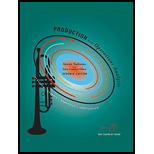
Concept explainers
a.
To determine: The ideal timing for making additions in plant and the optimal size to make each addition.
Introduction: Based on the past experiences, a chemical firm can evaluate the present and the future circumstances of the firm. It can also predict the optimal timing to make additions in plant and the optimal size of each addition mathematically.
b.
To determine: The cost of each addition incurred by the chemical firm.
Introduction: In the process of determining optimal timing of plant additions and the optimal size of each addition, the chemical firm has also to bear some costs in addition of each optimal plants. This can be enumerated arithmetically.
c.
To determine: The present value of the next four future additionsof the chemical firm.
Introduction: The process of adding optimal plants is money consuming strategy of the chemical firm. While evaluating this process, the present value of the next few future additions can be calculated.
Want to see the full answer?
Check out a sample textbook solution
Chapter 1 Solutions
Production and Operations Analysis, Seventh Edition
- What is capacity planning, and what are the key considerations in determining the optimal capacity for a production system?arrow_forwardDefine what you mean by "what-if analysis." How might a spreadsheet be used in capacity planning?arrow_forwardWhat steps are necessary in the capacity planning? differentiate between product capacity and service capacity with proper points without plagiarism.arrow_forward
- Management may choose to build up capacity in anticipation of demand or in response to developing demand. Cite the advantages and disadvantages of both approaches.arrow_forwardLevel Capacity Production Plan Problem o Manager T. C. Downs of Plum Engines, a producer of lawn mowers and leaf blowers, must develop an aggregate plan given the forecast for engine demand shown in the table. The department has a steady regular output capacity of 130 engines per month. Regular output has a cost of $60 per engine. The beginning inventory is zero engines. Overtime has a cost of $90 per engine. o Develop a Level capacity plan and compute the total cost of Ending Inventory. MONTH 1 2 3 4 6 7 8. Forecast 120 135 140 120 125 125 140 135arrow_forwardGiven the following four capacity alternatives, find the best production method for every production volume. Method Fixed Cost ($) Variable Cost ($/unit) A 200 5 100 10 C 150 4 D 250 2.arrow_forward
- Explain the factor which affects the capacity planning frequency.arrow_forwardProduction Management 1. Give 2 ways, each with ONE example, how capacity might be a. increased in the short to medium term b. decreased in the short to medium term ii. List and discuss THREE factors that may determine effective capacityarrow_forwardThe planner at a company that makes garden tractors is about to prepare an aggregate production plan that will cover the next 6 months. She has collected the following information: Month Demand Forecast Above the available capacity through permanent workforce 1 1,000 2 1,000 3 2,000 4 3,000 5 4,000 6 1,000 Total: 12,000 Production per month = 20 units per worker Initial inventory = 500 units Desired ending inventory (at the end of month 6) = 0 units Cost: Hire cost = $500 per temporary worker Inventory = $10 per tractor per month Backorder = $150 per tractor per month The optimum aggregate plan is: Month 1 2 3 4 5 6 Total Forecast Demand above regular capacity 1,000 1,000 2,000 3,000 4,000 1,000 12,000 # of temporary workers required 50 50 100 150 200 50 Temp. Workers hired 25 25 50 75 0 0 Temp. workers laid off 0…arrow_forward
- Effective capacity is: Multiple Choice a. also called theoretical capacity. b. base capacity plus time for maintenance, breaks, and absenteeism. c. the amount of capacity that can be used in planning for actual output. d. All of these choices are correct.arrow_forwardHill’s operations manager (see Problems 13.3 through13.5) is also considering two mixed strategies for January–August: Produce in overtime or subcontracting only when there isno inventory.◆ Plan D: Keep the current workforce stable at producing1,600 units per month. Permit a maximum of 20% overtime atan additional cost of $50 per unit. A warehouse now constrainsthe maximum allowable inventory on hand to 400 units or less.◆ Plan E: Keep the current workforce, which is producing 1,600units per month, and subcontract to meet the rest of the demand.Evaluate plans D and E and make a recommendation.arrow_forwardA biotech firm is considering abandoning its old plant, built 23 years ago, andconstructing a new facility that has 50% more square footage. The original cost of the old facility was $300,000, and its capacity in terms of standardizedproduction units is 250,000 units per year. The capacity of the new laboratoryis to be 400,000 units per year. During the past 23 years, costs of laboratoryconstruction have risen by an average of 5% per year. If the cost-capacity factor, based on square footage, is 0.80, what is the estimated cost of the newlaboratory?arrow_forward
 Practical Management ScienceOperations ManagementISBN:9781337406659Author:WINSTON, Wayne L.Publisher:Cengage,
Practical Management ScienceOperations ManagementISBN:9781337406659Author:WINSTON, Wayne L.Publisher:Cengage,
